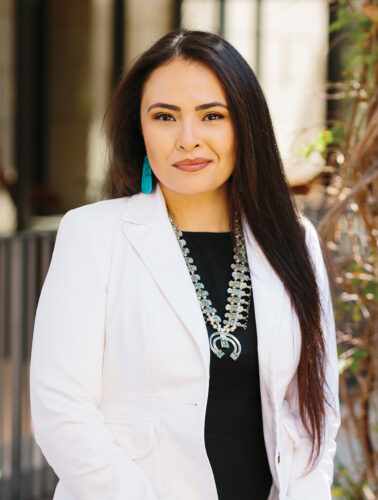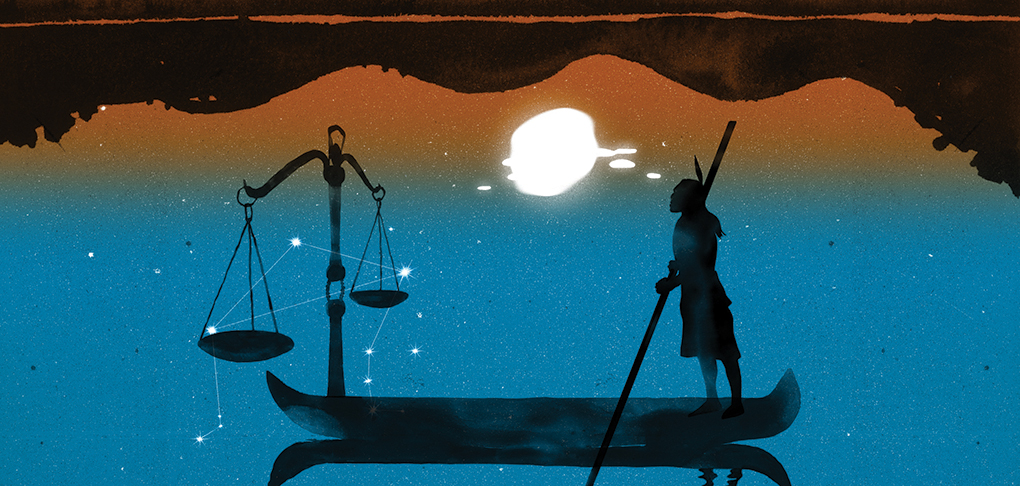Fighting for the Future of Indian Law
Stanford’s Growing Program in American Indian and Indigenous Law is on the Front Lines, from the Supreme Court to Tribal Council Chambers

When the U.S. Supreme Court heard oral arguments last fall in a controversial case challenging a law requiring states to make every effort to place Native children who have been removed from their homes with members of their family, tribe, or another Native nation, dozens of Stanford Law School students and faculty had gathered to listen to the live audio.
The case, Brackeen v. Haaland, was called at 7:02 a.m. Pacific time, but the SLS contingent was wide awake. They each had an interest in the outcome. Some of the listeners are Native American themselves and have relatives or friends who can recall when their children were forcibly removed from their homes and tribes before the law in question, the Indian Child Welfare Act (ICWA), was passed in 1978. Professor Gregory Ablavsky solo-authored amicus briefs for the 5th U.S. Circuit Court of Appeals and the high court in support of the federal government in the case. First-year students in Professor Elizabeth Reese’s discussion group had been studying ICWA and the underlying lawsuit for weeks. Professors Pamela S. Karlan and Jeffrey L. Fisher and students in the Supreme Court Litigation Clinic represented the Navajo Nation in the matter and most of the group had been present when Reese, Ablavsky, Karlan, and Fisher mooted the lead attorney for the tribes supporting the law.
The Supreme Court upheld the law in a 7-2 decision on June 15, but the case was just the latest example of the high stakes for long-standing principles of tribal sovereignty in this country.
The campus listening party was pedagogical in nature—it was the first chance for most of the 1Ls present to study a statute and see it debated at the highest court in the land. But the gathering was also a show of community for Stanford’s growing American Indian and Indigenous Law program, led by Ablavsky and Reese. The area gained real traction in 2015 with the hiring of Ablavsky, the first Stanford professor with expertise in the field; Reese joined the faculty in 2021 as the first American Indian professor. Today the program encompasses everything from studying Indian law in the classroom to working on behalf of tribes in policy practicums. The students and faculty gathered on November 9, 2022, weren’t just listening to the oral arguments—they were invested in the case. Reese, a scholar of American Indian tribal law, federal Indian law, and constitutional law, is a citizen of Nambé Pueblo. She brought donuts for the occasion.
“I had nothing like this when I was in law school,” says Reese, whose Tewa name, Yunpoví, means Willow Flower. “I couldn’t have dreamed of anything like this Indian law program. We were sitting there in the room listening live when the justices referenced some research that Professor Ablavsky had done. It was very cool.”
Changing Course
The term Indian law often encompasses two broad categories: tribal law and federal Indian law. Tribal law is exactly what it sounds like—the laws and governing mechanisms that each of this country’s 574 federally recognized, sovereign Native nations have created for themselves since before the creation of the United States. Federal Indian law, on the other hand, refers to laws enacted by the United States to govern relations between the U.S. and tribes.
When Ablavsky arrived at SLS, the law school’s clinics were already working for and with tribes, including on important environmental,
religious liberty, and educational matters, and there was a community of Native students and their allies, represented by the Native American Law Students Association (NALSA). But, while some faculty incorporated tribal issues into their curricula, courses dedicated to Indian law were taught only every few years by visiting professors or adjuncts.
Federal Indian Law is now offered every year, taught by Ablavsky or Reese (in one recent quarter, it was the highest enrolled class at the law school). In addition, Ablavsky created a policy practicum—Federal Indian Law: Yurok Legal Assistance—in which students work with the tribal attorneys of the largest federally recognized Native nation in California on issues ranging from water rights and police powers to tribal-county relationships. And Reese, who in April took a temporary leave from SLS to join the White House Domestic Policy Council as the senior policy adviser for Native affairs, teaches Tribal Law and leads 1L discussion groups on Native issues, like the one
on Brackeen.
In a 2021 Stanford Law Review article called “The Other American Law,” Reese argued that Tribal law should be taught and studied alongside and within mainstream legal subjects. When she joined the faculty that same year, she says the foundation of Indian law offerings was “fantastic.”

“There was already a lot going on,” she explains. “The norm at other law schools would be only stuff that I planned or NALSA planned. Here, the work was already happening.”
Tanner Allread, JD ’22/PhD ’25, a citizen of the Choctaw Nation who is finishing his PhD in history, says the fact that Federal Indian Law was a mainstay of the SLS curriculum was a major draw.
“That really sold me,” he says. “I felt that I would have a lot of support as a Native student.”
Choctaw citizen Carson Smith, JD ’25 (BA ’19), who studied political science and Native American studies as an undergraduate, agrees.
“I applied to other law schools,” she says. “But it had to be Stanford. Professors Ablavsky and Reese were the really big sell. Most campuses don’t even have one tenure-track law professor focused on this area—we have two.”
Jenny Martinez, the Richard E. Lang Professor of Law and Dean of Stanford Law School, says SLS is “proud of its growing tribal law and federal Indian law program, which is unmatched among top law schools.”
“Liz and Greg are both pushing the field forward and engaging professionally with the most important questions in this area,” she says. “What’s more, the students love them.”
Drawing on the Past to Shape the Future
As lead faculty, Ablavsky and Reese bring with them complementary backgrounds and experience.
Ablavsky taught fifth grade on the Zuni Reservation in New Mexico before law school. In addition to his JD, he has a PhD in history and specializes in issues related to sovereignty, territory, and property in the founding era—expertise that is in very high demand at a time when the U.S. Supreme Court is dominated by originalists.
An award-winning author, Ablavsky won both the Law and Society Association’s James Willard Hurst Book Prize and the American Society for Legal History’s William Nelson Cromwell Foundation Book Prize for his 2021 book, Federal Ground: Governing Property and Violence in the First U.S. Territories. He has written amicus briefs in several high-profile cases, and his historical perspective is highly relevant for judges who must decide present-day controversies with centuries-old statutes or case law. In the Supreme Court’s decision last year in Oklahoma v.
Castro-Huerta, which held that states can prosecute crimes by non-Indians against Indians in Indian country, Justice Neil Gorsuch cited Ablavsky’s work in a scorching dissent (in a forthcoming law review article, Ablavsky argues that Castro-Huerta is an example of opinions based on “bad” history). And in the 5th Circuit’s fractured en banc decision in Brackeen, judges who voted to uphold ICWA cited Ablavsky’s articles and amicus brief more than 40 times.
“The law has always been tied up with conquest. But it's also tied up with our sovereignty.”
Elizabeth Reese, assistant professor of law

“Greg is an incredible historian,” Reese says. “He’s able to do really powerful and important work, particularly because the Supreme Court is so focused on originalism right now. On the flip side, I’m very plugged into the contemporary Native community, the fights that tribes are fighting, the way that tribes are building themselves up as governing institutions.”
Reese spent her early childhood in Nambé in New Mexico. After law school, she worked at the NAACP Legal Defense Fund and later the National Congress of American Indians, where she helped tribal governments implement certain powers to prosecute non-Indians restored to them under the 2013 Violence Against Women Act (a 1978 Supreme Court case, Oliphant v. Suquamish Indian Tribe, held that tribal courts cannot prosecute non-Indians except where Congress has specifically given them the power to do so). In that role, she reviewed tribal codes and worked with tribal judges, attorneys, and victim advocates on the legal requirements of jurisdiction under the law.
Reese spends much of her time laying the groundwork for the future of tribal and federal Indian law. In 2021, she testified before the U.S. Senate Committee on Indian Affairs in favor of expanded criminal jurisdiction for tribes under the Violence Against Women Act. In part based on her testimony—and the comprehensive report she produced for the National Congress of American Indians—Congress granted tribes the power to prosecute additional crimes under the law.
Her scholarly work is likewise forward looking. Reese’s article “The Other American Law,” published in the Stanford Law Review, calls for enhanced access to tribal laws and court decisions and for the inclusion of tribal law cases in the first-year legal curriculum. Reese is currently working on an article about tribal representation in Congress, one of many unfulfilled promises made by the federal government.
“Tribes don’t have senators and congresspeople. The fact that they’re lumped in with states, which are competing sovereigns for resources and land, has never made sense,” she says. “My work is always thinking about and demanding systems that fully recognize tribal sovereignty. What does that really look like? Some of the things we’re currently fighting about are the bare minimum.”
Engaging Students
Ablavsky and Reese regularly involve students in their research and writing. Several students worked with Ablavsky on his Brackeen amicus brief; Allread helped prepare Reese for her Senate testimony and is a co-author with Ablavsky on “We the (Native) People?: How Indigenous Peoples Debated the U.S. Constitution,” published in the Columbia Law Review.
“Professor Ablavsky has been the most amazing mentor and adviser and supporter,” Allread says. “I was very honored that he asked me to work with him.”
Allread has a piece of his own forthcoming in the Columbia Law Review. The article, which builds on a paper he wrote for a class Ablavsky taught called Law and Empire in U.S. History, returns Oklahoma’s state power argument in Castro-Huerta to its original context: the era of Indian Removal, when tribes were forced from their land to make way for white settlers.
In Reese’s Tribal Law class, students research the law and policies of individual tribes or small groups of tribes that have banded together. Eventually, Reese hopes to make their research accessible to other scholars and practitioners—part of her overriding goal to bring tribal law into the mainstream.
In “The Other American Law,” Reese highlights three case studies showing how tribes—a catchall term first used by the U.S. government to describe precolonial governments that, as she writes, “we ought to call by the names they call themselves”—have dealt with some of the same kinds of legal questions that other U.S. jurisdictions deal with: criminal procedure, separation of powers, and election law.
“While this article also argues that tribes have much to offer if included in the mainstream, it also suggests that tribes should not need to prove their value to warrant mainstream attention,” she writes. “Instead, they simply belong in the mainstream, alongside our study of the other governments of the United States, because they are also a part of this nation.”
“They give us the opportunity to work with them; we supply the students' time and energy.”
Professor Greg Ablavsky about the policy practicum he launched working with the Yurok Tribe
Outside of the research realm, students have long had the opportunity to work with tribes through Stanford Law School’s clinics, addressing issues that range from religious freedom and equity in education to water rights and protecting sacred lands from development. Ablavsky and Reese have expanded those opportunities through the American Indian and Indigenous Law program.
Several years ago—after a chance meeting with a Yurok official at a conference—Ablavsky created the Yurok Legal Assistance policy practicum. Unlike clinics that work in specific practice areas, the practicum is a partnership in which SLS students assist the Yurok Tribe on any legal questions they have.
“It’s a win-win,” Ablavsky says. “The Yurok Tribe has various kinds of legal research they need help with, but their attorneys don’t always have the capacity to work on longer-term projects. We have a bunch of eager students who are interested in this area of the law and serving Indian country. They give us the opportunity to work with them; we supply the students’ time and energy.”
In the past, students have helped the Yurok with questions about the removal of a dam on the Klamath River, the administration of benefits, and drafting tribal code to encourage economic development, among other topics.
Smith took the practicum as an undergraduate and again as a 1L: “I felt like I was actually doing something meaningful,” she says, “and didn’t have to be trapped in an ivory tower.”

Carson Smith, JD ’25 (BA ’19); Madi Burson, JD ’24; Makena Kauhane, JD ’25; Marissa Uri, JD ’25
Reese and Ablavsky are proactive in connecting students with other experiential opportunities as well. Allread interned at top Indian law firm Kanji & Katzen; Smith will work at the firm this summer. After a referral from Reese, Emily Bruell, JD ’24, spent most of her 2L year assisting the California Rural Indian Health Board in efforts to access COVID data from counties arguing that the California Information Practices Act prevents them from sharing the data with tribes.
“Obviously this information is critical to managing disease and public health,” Bruell says. “When it comes to the spread of disease, tribes don’t exist in a bubble; they’re very interdependent with surrounding counties.”
There is also plenty of pro bono work for students interested in Indian law. In 2021, Daniel Ahrens, JD ’23, and Sam Becker, JD ’22, co-founded the Native Law Pro Bono Project, in which students partner with two legal aid organizations—the Northwest Justice Project and California Indian Legal Services—to conduct legal research and assist on direct-service projects.
This year, Ella Bohn, JD ’24, has co-led the work with California Indian Legal Services, which has included land improvement projects, prescribed burning for cultural practices, and access to sacred sites located on private lands. For the Northwest Justice Project, students help Native clients draft wills to protect their tribal lands. Students can also work with Yurok Tribe members on their wills through an alternative spring break supported by NALSA and the Stanford Public Interest Law Foundation.
“There are a lot of points of entry for students interested in this area of the law,” Bohn says. “It’s also an area of law where I felt I could really be additive and helpful. There’s a need for good advocates in Indian country.”
Read NALSA: 50 Years of SLS Native Community
Building and Empowering Community
A central component of Stanford’s American Indian and Indigenous Law program is community. A strong support system is imperative in an area of the law in which the government’s past policies have included indiscriminate killing and termination—disbanding tribes and selling their land. After all, for Native students, these cases—Brackeen and Castro-Huerta and countless more dating back to the early 19th century—are tied up with questions about their collective identity, or, as Reese says, the “ability of our communities to thrive and survive.”
“It’s hard because some of these cases are about the Trail of Tears, about, effectively, my tribal community experiencing an act of genocide,” Smith says. “Those are really difficult things to navigate.”
Stanford University has a long history of Native activism and community. The Stanford American Indian Organization, founded in 1970, successfully fought to remove the Indian mascot as the university’s athletic symbol; the Native American Cultural Center opened on campus in 1974. At SLS, Reese and Ablavsky see themselves as facilitating and expanding on that existing community. They make themselves available to students inside and outside of the classroom; they write letters of introduction and recommendation; Reese hosts students at her home for traditional meals.
“They are fantastic human beings,” Smith says. “I know they don’t value me just for my academics; they value me as a person.”
Bohn agrees. “They go out of their way to be really involved with students,” she says. “They are valuable community members in addition to being professors who are really smart.”
Reese says training the next generation of tribal and federal Indian law attorneys is one of the best parts of her work as a professor.
“The law has always been tied up with conquest,” she says. “But it’s also tied up with our sovereignty. The law has done some of the most harmful things to tribes and also ensured some of the most important protections. It is a vital tool, and it is my job to train people in this profession to wield that tool effectively and powerfully.” SL
Rebecca Beyer is a freelance writer and editor in the Boston area.

